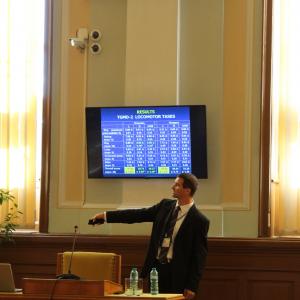Education for Health and Performance - scientific conference and project meeting
11-12th October 2019. , Cluj-Napoca, Romania
Does the gross motor development of Romanian and Hungarian 6 – 7-year-old children depend on the degree of obesity? – First phase of a longitudinal study
Introduction and aim: In Hungary (HU) there are everyday PE lessons (5 per week), while there are fewer PE lessons (2 per week) in Romania (RO). We compare RO and HU children who started to attend primary school in the last semester and we hypothesize that more regular PE lessons have more positive effect on motor development due to the improvement in the degree of obesity.
Methods: 361 children from both countries and genders (RO: 132 boys and 116 girls; HU: 57 boys and 56 girls) participated in the study. They were classified by BMI percentiles to lean (L; p<25%), normal (N; 25%<p<75%) and overweight/obese (OOB; p>75%) categories. Their motor development was measured by Test of Gross Motor Development-2 (TGMD-2) which contains locomotor (run, gallop, hop, leap, horizontal jump, slide) and object control (striking a stationary ball, stationary dribble, catch, kick, overhand throw, underhand roll) tasks.
Results: The rate of L or OOB pupils was similar in both countries. There were no differences between the BMI categories in either countries in the results of different locomotor and object control tasks. N and OOB RO pupils achieved higher scores in hop than HU children in the same BMI categories. In the overall results of locomotor tasks L HU pupils were significantly better than OOB HU children and L RO pupils achieved higher points than N or OOB RO children. N or OOB RO pupils’ overall locomotor scores were higher than HU children in the same BMI categories. The N RO children’s results of catch were lower than N HU pupils’ results. In the overall results of object control tasks, there were no differences among the BMI categories or the countries. In the cumulate outcome of TGMD-2, the OOB HU pupils’ scores were lower than the L or N HU children’s scores. The OOB RO pupils achieved higher overall TGMD-2 scores than the OOB HU children.
Conclusions and further perspectives: Our results seem to prove that the OOB children’s motor skills are weaker. We detected a few differences between RO and HU pupils’ motor development, but we would like to perform the same examinations once in the following semesters among the same children. Now we reported the results of the first measurement period. We suppose that the differences would be more remarkable when the pupils spend
more time in the system of everyday PE or 2 PE lessons per week.
Abstract available for download below.







